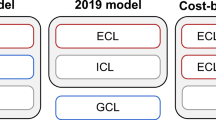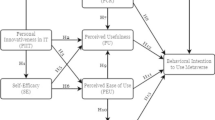Abstract
Governmental jobs in India are the most desirable choice that demand effective and transparent public administration for better government–citizen relationships. This study integrates technology acceptance model and theory of planned behaviour as conceptual framework to explain the adoption of online job application system in Indian e-government context. Website’s ability provides accurate information to facilitate job application online and more specifically the degree of fit applicants perceive between online behaviour and traditional behaviour is notable in influencing acceptance of such systems. Data were collected personally from usable response of 443 respondents in Gujarat, India, using intercept survey. The data were analysed through structural equation modelling. Findings revealed that combined TPB–TAM model with website informativeness and compatibility provided an empirical confirmation in explaining online job application system.


Similar content being viewed by others
References
Ajzen I (1985) From intentions to actions: a theory of planned behaviour. Springer, Berlin, pp 11–39
Ajzen I (1991) The theory of planned behaviour. Organ Behav Hum Decis Process 50:179–211
Ajzen I (2002) Perceived behavioural control, self-efficacy, locus of control, and the theory of planned behaviour. J Appl Soc Psychol 32(4):665–683
Ajzen I, Fishbein M (1980) Understanding attitudes and predicting social behaviour. Prentice-Hall, Englewood Cliffs
Anderson N (2003) Applicant and recruiter reactions to new technology in selection: a critical review and agenda for future research. Int J Select Assess 11(2–3):121–136
Armitage CJ, Conner M (2001) Efficacy of the theory of planned behaviour: a meta-analytic review. Br J Soc Psychol 40:471–499
Arnold J, Loan-Clarke J, Coombs C, Wilkinson A, Park J, Preston D (2006) How well can the theory of planned behaviour account for occupational intentions? J Vocat Behav 69:374–390
Bagozzi R, Yi Y (1988) On the evaluation of structural equation models. J Acad Mark Sci 16:74–94
Bagozzi R, Yi Y, Phillips W (1991) Assessing construct validity in organizational research. Adm Sci Q 36:421–458
Bandura A (1982) Self-efficacy mechanism in human agency. Am Psychol 37:122–147
Banerjee P, Gupta R (2019) Talent attraction through online recruitment websites: application of Web 2.0 Technologies. Austr J Inf Syst. https://doi.org/10.3127/ajis.v23i0.1762
Baroudi JJ, Olson MH, Ives B (1986) An empirical study of the impact of user involvement on system usage and information satisfaction. Commun ACM 29(3):232–238
Bhattacharya D, Gulla U, Gupta MP (2011) E-service quality model for Indian government portals: Citizens’ perspective. J Enterp Inf Manag 25(3):246–271
Bhattacherjee A (2000) Acceptance of e-commerce services: the case of electronic brokerages. IEEE Trans Syst Man Cybern A Syst Hum 30(4):411–420
Boomsma A (1987) The robustness of maximum likelihood estimation in structural equation models. In: Cuttance P, Ecob R (eds) Structural modeling by example Place of publication? Cambridge University Press, Cambridge, pp 160–188
Bryant S (2000) Top executives shun Internet recruitment. Manag Account Mag Chart Manag Account 78(4):1–4
Byrne BM (1998) Structural equation modeling with LISREL, PRELIS, and SIMPLIS. Lawrence Erlbaum, Hillsdale
Cappelli P (2001) Making the most of on-line recruiting. Harv Bus Rev 79(3):139
Chakraborty G, Lala V, Warren D (2003) What do customers consider important in B2B websites? J Advert Res 43(1):50–61
Chapman DS, Uggerslev KL, Carroll SA, Piasentin KA, Jones DA (2005) Applicant attraction to organizations and job choice: A meta-analytic review of the correlates of recruiting outcomes. J Appl Psychol 90:928–944
Chau PK, Hu PJ (2002) Examining a model of information technology acceptance by individual professionals. J MIS 18(4):191–229
Chen Y-H, Corkindale D (2008) Towards an understanding of the behavioural intention to use online news services: an exploratory study. Internet Res 18(3):286–312
Chen M-F, Lu T-Y (2011) Modeling e-coupon proneness as a mediator in the extended TPB model to predict consumers’ usage intentions. Internet Res 21(5):508–526
Cheng Y-M (2014) Exploring the intention to use mobile learning: the moderating role of personal innovativeness. J Syst Inf Technol 16(1):40–61
Cober RT, Brown DJ, Blumental AJ, Doverspike D, Levy P (2000) The quest for the qualified job surfer: it’s time the public sector catches the wave. Public Pers Manag 29(4):479–496
Cober RT, Brown DJ, Levy PE (2004) Form, content, and function: an evaluative methodology for corporate employment websites. Hum Resource Manag 43(2–3):201–218
Costantini A, Ceschi A, Sartori R (2019) The theory of planned behaviour as a frame for job crafting: explaining and enhancing proactive adjustment at work. In: Van Zyl LE, Rothmann S (eds) Theoretical approaches to multi-cultural positive psychological interventions. Springer, Cham, pp 161–177
Davis FD (1989) Perceived usefulness, perceived ease of use, and user acceptance of information technology. MIS Q 13(3):319–340
Davis FD, Bagozzi RP, Warshaw PR (1989) User acceptance of computer technology: a comparison of two theoretical models. Manage Sci 35(8):982–1003
Davis FD, Venkatesh V (1996) A critical assessment of potential measurement biases in the technology acceptance model: three experiments. Int J Hum Comput Stud 45:19–45
Davis FD (1986) A technology acceptance model for empirically testing new end-user information systems: Theory and results. (Unpublished doctoral dissertation). MIT Sloan School of Management, Cambridge.
Derous E, de Fruyt F (2016) Developments in recruitment and selection research. Int J Select Assess 24(1):1–3
Deshpande R, Zaltman G (1982) Factors Affecting the use of market research information: a path analysis. J Mark Res 19:14–31
Deshpande R, Zaltman G (1987) A comparison of factors affecting use of marketing information in consumer & industrial firms. J Mark Res 24(February):114–118
Faiers A, Neame C, Cook M (2007) The adoption of domestic solar-power systems: Do consumers assess product attributes in a stepwise process? Energy Policy 35(6):3418–3423
Fan L, Gu J-C, Suh Y-H, Lee S-C (2012) How to attract Chinese online game users: an empirical study on the determinants affecting intention to use Chinese online games. Asian J Qual 13(1):7–21
Fornell C, Larcker D (1981) Evaluating structural equation models with unobservable variances and measurement error. J Mark Res 18:39–50
Fusilier M, Durlabhji S (2005) An exploration of student Internet use in India. Campus-Wide Inf Syst 22(4):233–246
Gaskin (2017). Confirmatory factor analysis http://statwiki.kolobkreations.com/index.php?title5Confirmatory_Factor_Analysis. Accessed 15 Sept 2019.
Gefen D, Karahanna E, Straub DW (2003) Trust and TAM in online shopping: an integrated model. MIS Q 27(1):51–90
Gopi M, Ramayah T (2007) Applicability of theory of planned behaviour in predicting intention to trade online: some evidence from a developing country. Int J Emerg Markets 2(4):348–360
Government of India (2005) National e-Governance Plan, Department of Information Technology, Ministry of Communications & Information Technology, Government of India
Hair JF, Anderson RE, Tatham RL, Black WC (1998) Multivariate data analysis, vol 5. Pearson Education Inc., Boston
Ho R (2006) Handbook of univariate and multivariate data analysis and interpretation with SPSS. Taylor & Francis Group, New York
Van Hooft EAJ, Born MPh, Taris TW, Van der Flier H (2006) Ethnic and gender differences in applicants’ decision-making processes: An application of the theory of reasoned action. Int J Select Assess 14:156–166
Hussein R, Mohamed N, Rahman A, Mahmud A, Mahmud M (2011) E-government application: an integrated model on G2C adoption of online tax. Transform Govern People Process Policy 5(3):225–248
Irani Z, Dwivedi YK, Williams MD (2009) Understanding consumer adoption of broadband: an extension of the technology acceptance model. J Oper Res Soc 60(10):1322–1334
Jaidi Y, Van Hooft E, Arendas L (2011) Recruiting highly educated graduates: A study on the relationship between recruitment information sources, the theory of planned behaviour and actual job pursuit. Hum Perform 24:135–157
Kashi K, Zheng C (2013) Extending technology acceptance model to the e-recruitment context in Iran. Int J Select Assess 21(1):121–129
Kelloway EK (1998) Using LISREL for structural equation modeling: A researcher’s guide. SAGE Publications Inc, Thousand Oaks
Kline RB (2005) Principles and practice of structural equation modeling, vol 2. Guilford, New York
Kulkarni M, Nithyanand S (2013) Social influence and job choice decisions. Employee Relat 35(2):139–156
Kurfali M, Arifoglu A, Tokdemir G, Pacin Y (2017) Adoption of e-government services in Turkey. Comput Hum Behav 66:168–178
Lau ASM (2002) Strategies to motivate brokers adopting on-line trading in Hong Kong financial market. Rev Pac Basin Financ Mark Policies 5(4):471–489
Lee J, Chen C, Song H, Lee C (2014) The role of responsible gambling strategy and gambling passion in the online gamblers’ decision-making process: Revising the theory of planned behaviour. J Gambl Stud 30(2):403–422
Lee Y-C, Hsieh Y-F, Guo Y-B (2013) Construct DTPB model by using DEMATEL: A study of a university library website. Program Electr Lib Inf Syst 47(2):155–169
Lee J (2003) Factors affecting intention to use online financial services. (Order No. 3159914, The Ohio State University). ProQuest Dissertations and Theses: 201.
Lievens F, Harris M (2003) Research on internet recruiting and testing: current status and future directions, vol 18. Wiley, Chichester
Lin H-F (2010) Applicability of the extended theory of planned behaviour in predicting job seeker intentions to use job-search websites. Int J Select Assess 18:64–74
Llorens JJ (2009) E-Recruiting. Paper presented at the Annual Meeting of the American Political Science Association, September 3–6, 2009, Toronto
Luo X (2002) Trust production and privacy concerns on the Internet: a framework based on relationship marketing and social exchange theory. Ind Mark Manage 31(2):111–118
Maree M, Kmail AB, Belkhatir M (2018) Analysis and shortcomings of e-recruitment systems: towards a semantics-based approach addressing knowledge incompleteness and limited domain coverage. J Inf Sci 45:713
McGorr S (2000) Measurement in a cross-cultural environment: survey translation issues. Qual Market Res 3:74–81
Montoya-Weiss M, Voss GB, Grewal D (2003) Determinants of online channel use and overall satisfaction with a relational, multichannel service provider. J Acad Mark Sci 31(4):448–458
Mostafa MM (2010) A structural equation modeling analysis of the animosity model of foreign product purchase in Egypt. Glob Bus Rev 11(3):347–363
Nunnally JC (1978) Assessment of reliability. In: Nunnally JC (ed) Psychometric theory. McGraw-Hill International, New York, pp 193–197
Panneervel P (2005) E-governance: a Change management tool. Rawat Publications, Jaipur
Pavlou PA (2003) Consumer acceptance of electronic commerce: integrating trust and risk with the technology acceptance model. Int J Electr Commerce 7(3):101–134
Pavlou PA, Fygenson M (2006) Understanding and prediction electronic commerce adoption: an extension of the theory of planned behaviour. MIS Q 30(1):115–143
Pavlou PA, Liang H, Xue Y (2007) Understanding an(d?) mitigating uncertainty in online exchange relationships: a principal agent perspective. MIS Q 31(1):105–135
Pdsakoff PM, MacKenzie SB, Lee J-Y, Podsakoff NP (2003) Common method biases in behavioural research: a critical review of the literature and recommended remedies. J Appl Psychol 88:879–903
Pfieffelmann B, Wagner SH, Libkuman T (2010) Recruiting on corporate websites: perceptions of fit and attraction. Int J Select Assess 18:40–47
Rana NP, Dwivedi YK, Williams MD (2013) A meta-analysis of existing research on citizen adoption of e-government. Inf Syst Front 17(3):547–563
Richard M-O (2005) Modeling the impact of Internet atmospherics on surfer behaviour. J Bus Res 12:1632–1642
Richard M-O, Chebat J-C (2016) Modeling online consumer behaviour: preeminence of emotions and moderating influences of need for cognition and optimal stimulation level. J Bus Res 69:541–553
Rogers EM (1962) Diffusion of innovations. The Free Press, New York
Rogers EM (1995) Diffusion of innovations. The Free Press, New York
Roy M-C, Chartier A, Crete J, Poulin D (2015) Factors influencing e-government use in non-urban areas. Electr Commerce Res 15:349–363
Rynes SL (1991) Recruitment, job choice, and post-hire consequences. In: Dunnette MD (ed) Handbook of industrial and organizational psychology, vol 2. Consulting Psychologists Press, Palo Alto, pp 399–444
Ryu MH, Kim S, Lee E (2009) Understanding the factors affecting online elderly user’s participation in video UCC services. Comput Hum Behav 25:619–632
Schmit MJ, Ryan AM (1997) Applicant withdrawal: the role of test-taking attitudes and racial differences. Pers Psychol 50:855–876
Schreurs B, Derous EV, Hooft E, Proost K, Witte K (2009) Predicting applicants’ job pursuit behaviour from their selection expectation: the mediating role of the theory of planned behaviour. J Organ Behav 30:761–783
Selden S, Orenstein J (2011) Government e-recruiting web sites: the influence of e-recruitment content and usability on recruiting and hiring outcomes in US state governments. Int Jo Select Assess 19(1):31–40
Shrout PE, Bolger N (2002) Mediation in experimental and nonexperimental studies: new procedures and recommendations. Psychol Methods 7:422–445
Shukla A, Sharma N, Swami S (2010) Website characteristics, user characteristics and purchase intention: mediating role of website satisfaction. Int J Internet Market Advert 6(2):142–167
Singh G, Pathak RD, Naz R, Belwal R (2010) E-governance for improved public sector service delivery in India, Ethiopia and Fiji. Int J Public Sector Manag 23(3):254–275
So JCF, Bolloju N (2005) Explaining the intentions to share and reuse knowledge in the context of IT service operations. J Knowl Manag 9(6):30–41
Spence M (1974) Market signaling: informational transfer in hiring and related screening processes. Harvard University Press, Cambridge
Sylva H, Mol T (2009) E-recruitment: a study into applicant perceptions of an online application system. Int J Select Assess 17(3):311–323
Taylor S, Todd P (1995) Understanding information technology usage: a test of competing models. Inf Syst Res 6(2):144–176
Thielsch MT, Träumer L, Pytlik L (2012) E-recruiting and fairness: the applicant’s point of view. Inf Technol Manage 13(2):59–67
Tong DYK (2009) A study of e-recruitment technology adoption in Malaysia. Ind Manag Data Syst 109(2):281–300
Tung FC, Chang S-C (2008) Nursing students’ behavioural intention to use online courses: a questionnaire survey. Int J Nurs Stud 45(9):1299–1309
Venkatesh V, Bala H (2008) Technology acceptance model 3 and a research agenda on interventions. Decis Sci 39:273–315
Venkatesh V, Morris MG, Ackerman PL (2000) A longitudinal field investigation of gender differences in individual technology adoption decision-making processes. Organ Behav Hum Decis Processes 83(1):33–60
Venkatesh V, Morris MG, Davis GB, Davis FD (2003) User acceptance of information technology: toward a unified view. MIS Q. 27(3):425–478
Wu J-H, Wang S-C (2005) What drives mobile commerce? An empirical evaluation of the revised technology acceptance model. Inf Manag 42(5):719–729
Wu J-H, Wang S-C, Lin L-M (2007) Mobile computing acceptance factors in the healthcare industry: a structural equation model. Int J Med Inf 76(1):66–77
Xue L, Yen CC, Chang L, Chan HC, Tai BC, Tan SB, Duh HBL, Choolani M (2012) An exploratory study of ageing women’s perception on access to health informatics via a mobile phone-based intervention. Int J Med Inf 81(9):637–648
Acknowledgements
We acknowledge that this study is supported from research funds of Indian Institute of Management, Ahmedabad, Gujarat, India.
Funding
There are no sources in the current document.
Author information
Authors and Affiliations
Corresponding author
Additional information
Publisher's Note
Springer Nature remains neutral with regard to jurisdictional claims in published maps and institutional affiliations.
Rights and permissions
About this article
Cite this article
Parikh, A., Patel, J.D. & Jaiswal, A.K. Managing job applications online: integrating website informativeness and compatibility in theory of planned behaviour and technology acceptance model. Decision 48, 97–113 (2021). https://doi.org/10.1007/s40622-020-00266-2
Accepted:
Published:
Issue Date:
DOI: https://doi.org/10.1007/s40622-020-00266-2




